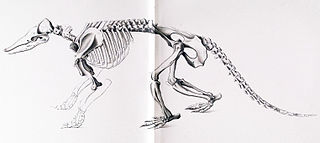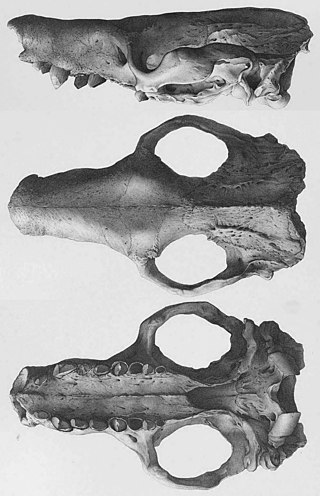
Cingulata, part of the superorder Xenarthra, is an order of armored New World placental mammals. Dasypodids and chlamyphorids, the armadillos, are the only surviving families in the order. Two groups of cingulates much larger than extant armadillos existed until recently: pampatheriids, which reached weights of up to 200 kg (440 lb) and chlamyphorid glyptodonts, which attained masses of 2,000 kg (4,400 lb) or more.

Peltephilus, the horned armadillo, is an extinct genus of dog-sized, armadillo xenarthran mammals which first inhabited Argentina during the Oligocene epoch, and became extinct in the Miocene epoch. Notably, the scutes on its head were so developed that they formed horns. Aside from the horned gophers of North America, it is the only known fossorial horned mammal.

Glyptotherium is a genus of glyptodont that lived from the Early Pliocene, about 4.9 million years ago, to the Early Holocene, around 7,000 years ago, in the United States, Mexico, Guatemala, Costa Rica, Honduras, El Salvador, Panama, Venezuela, and Brazil. The genus was first described in 1903 by American paleontologist Henry Fairfield Osborn with the type species being, G. texanum, based on fossils that had been found in the Pliocene Blancan Beds in Llano Estacado, Texas, USA. The genus has since been discovered in many more fossil sites. Another species, G. cylindricum, was named in 1912 by fossil hunter Barnum Brown on the basis of a partial carapace, teeth, and several additional fossils that had been unearthed from the Pleistocene deposits in Jalisco, Mexico.

Pyrotherium is an extinct genus of South American ungulate, of the order Pyrotheria, that lived in what is now Argentina and Bolivia, during the Late Oligocene. It was named Pyrotherium because the first specimens were excavated from an ancient volcanic ash deposit. Fossils of the genus have been found in the Deseado and Sarmiento Formations of Argentina and the Salla Formation of Bolivia.

Rhynchippus is an extinct genus of notoungulate mammals from the Late Oligocene of South America. The genus was first described by Florentino Ameghino in 1897 and the type species is R. equinus, with lectotype MACN A 52–31. Fossils of Rhynchippus have been found in the Agua de la Piedra and Sarmiento Formations of Argentina, the Salla and Petaca Formations of Bolivia, the Tremembé Formation of Brazil, and the Moquegua Formation of Peru.

Hoplophorus is an extinct genus of glyptodont, a subfamily of armadillos. The only confidently known species was H. euphractus, found in Pleistocene deposits in Brazil, though fossils possibly from another species are known from Bolivia.

Glyptodon is a genus of glyptodont that lived from the Pleistocene, around 2.5 million years ago, to the Early Holocene, around 11,000 years ago, in Argentina, Uruguay, Paraguay, Bolivia, Peru, Brazil, and Colombia. It was the first named extinct cingulate and is the type genus of Glyptodontinae, and, or, Glyptodontinae. Many species have been named for the genus, though few are considered valid, and it is one of, if not the, best known genus of glyptodont. Hundreds of specimens have been referred to the genus, but the holotype, or name specimen, of the type species, G. clavipes, was described in 1839 by notable British paleontologist Sir Richard Owen. The holotype used by Owen is a chimera of fossils from 3 different localities, including a molariform used for the name of the genus that actually belongs to Panochthus, making it a species inquirenda.

Stegotherium is an extinct genus of long-nosed armadillo, belonging to the Dasypodidae family alongside the nine-banded armadillo. It is currently the only genus recognized as a member of the tribe Stegotheriini. It lived during the Early Miocene of Patagonia and was found in Colhuehuapian rocks from the Sarmiento Formation, Santacrucian rocks from the Santa Cruz Formation, and potentially also in Colloncuran rocks from the Middle Miocene Collón Curá Formation. Its strange, almost toothless and elongated skull indicates a specialization for myrmecophagy, the eating of ants, unique among the order Cingulata, which includes pampatheres, glyptodonts and all the extant species of armadillos.

Macroeuphractus is a genus of extinct armadillos from the Late Miocene to Late Pliocene of South America. The genus is noted for its large size, with Macroeuphractus outesi being the largest non-pampathere or glyptodont armadillo discovered, as well as its specializations for carnivory, unique among all xenarthrans.
Kelenkura is an extinct genus of heavily armored mammals belonging to the subfamily Glyptodontinae, from the family Chlamyphoridae that contain most of the modern armadillos. It was a medium-sized South American animal, distantly related to Doedicurus. Fossils of this genus were recovered in the Arroyo Chasicó Formation and in the Loma de Las Tapias Formation of Argentina in rocks dating back to the Late Miocene epoch.
Epipeltephilus is an extinct genus of armadillo, belonging to the family Peltephilidae, the "horned armadillos", whose most famous relative was Peltephilus. Epipeltephilus is the last known member of its family, becoming extinct during the Chasicoan period. It was found in the Rio Mayo Formation and the Arroyo Chasicó Formation of Argentina, and in northern Chile.
Proadinotherium is an extinct genus of toxodontid. It lived between the Late Oligocene and the Early Miocene in what is now South America.
Taubatherium is an extinct genus of mammal, belonging to the order Notoungulata. It lived during the Late Oligocene, in what is today Brazil, in South America.
Simomylodon is an extinct genus of ground sloths from the family Mylodontidae. It lived from the Late Miocene to the Middle Pliocene of what is now Bolivia and Argentina, 5.3 to 2.8 million years ago. The most important find material comes from the central Altiplano in Bolivia and includes several skulls and dentition remains. Thus, the so far documented body skeleton is the best known and most significant of a Miocene representative of the Mylodontidae. On the basis of the remains, it can be concluded that it is a rather small member of the Mylodontidae. The construction of the limbs supports ground-dwelling locomotion, but this does not exclude occasional digging or climbing. The type and only known species is Simomylodon uccasamamensis.
Pascualihippus is an extinct genus of notoungulate belonging to the family Notohippidae. It lived during the Late Oligocene, in what is now Bolivia.

Scirrotherium is an extinct genus of pampatheres, a family of herbivorous cingulates, related to the similar but smaller modern armadillos, and with the now extinct glyptodonts, well-known from their shell-like armor. Its scientific name is derived from the Greek prefix "skiros-", "cover", and the suffix "-therion, "beast", while the name of the type species, hondaensis, honors the town of Honda, in the Tolima Department of Colombia. Scirrotherium is one of several genera of xenarthrans found in the La Venta fauna, dated from the Middle Miocene.
Eucinepeltus is an extinct genus of Glyptodont. It lived during the Early Miocene, and its fossilized remains were discovered in South America.
Vassallia is an extinct genus of cingulate belonging to the family Pampatheriidae. It lived between the Middle Oligocene and the Early Pliocene in what is now South America.

Cochlops is an extinct genus of glyptodont. It lived from the Early to Middle Miocene, and its fossilized remains have been found in South America.
Fredszalaya is an extinct genus of omnivorous mammal, belonging to the order Sparassodonta. It lived during the Late Oligocene, and its fossilized remains were discovered in South America.













